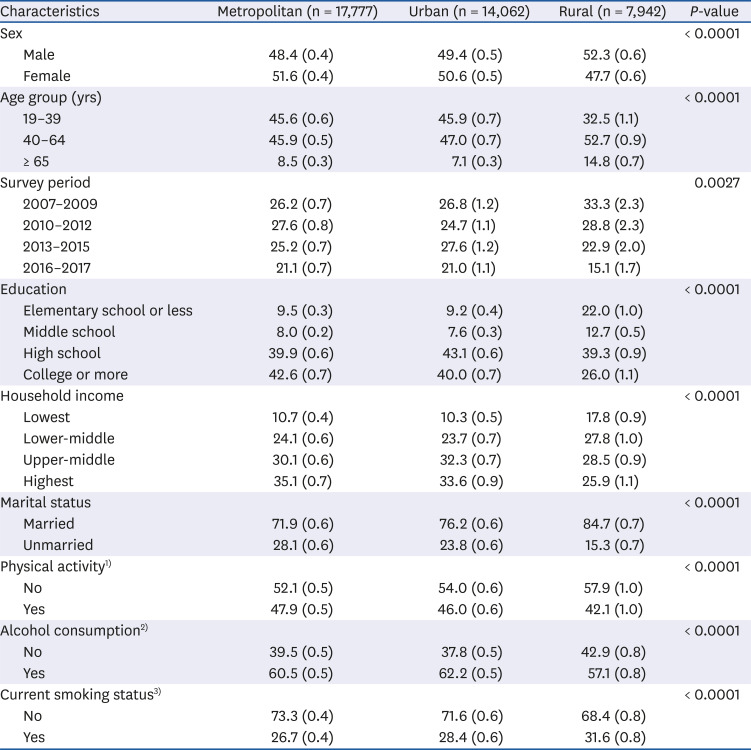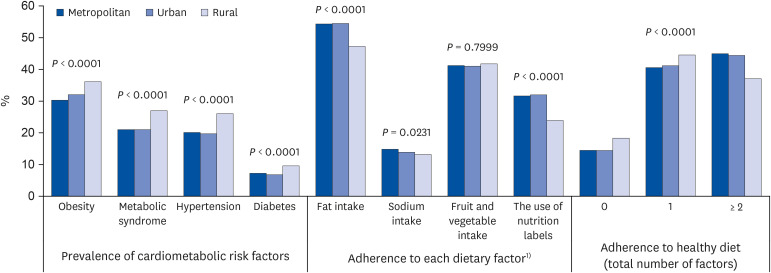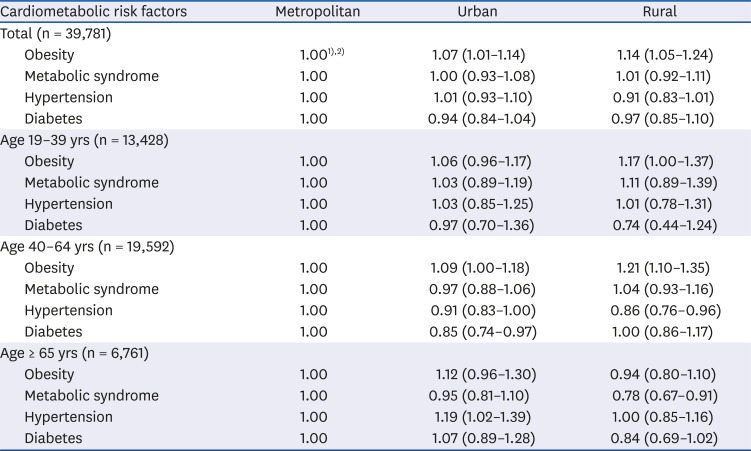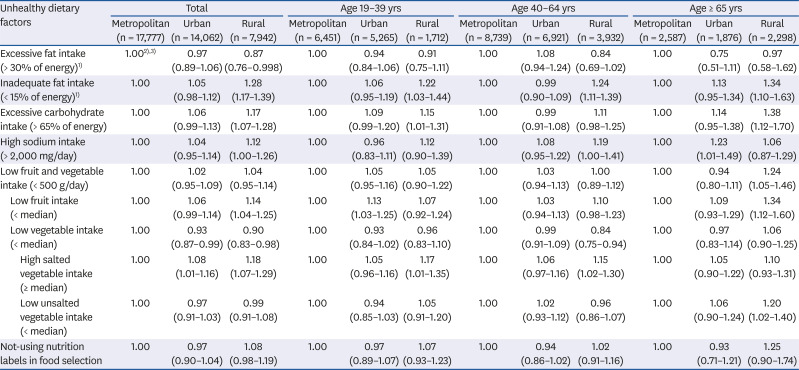2. World Health Organization. A Conceptual Framework for Action on the Social Determinants of Health. Geneva: World Health Organization;2010.
4. Institute of Medicine. Challenges and Successes in Reducing Health Disparities: Workshop Summary. Washington, D.C.: National Academies Press;2008.
5. Ministry of Health and Welfare. The National Health Plan 2020. Seoul: Ministry of Health and Welfare;2011.
6. Korean Society for Equity in Health. Regional Health Disparity Profiles. Seoul: Korean Society for Equity in Health;2018.
11. Song YJ, Joung HJ, Paik HY. Socioeconomic, nutrient, and health risk factors associated with dietary patterns in adult populations from 2001 Korean National Health and Nutrition Survey. Korean J Nutr. 2005; 38:219–225.
16. Ministry of Health and Welfare, Korea Health Promotion Foundation. The 4th Health Plan 2016–2020. Seoul: Korea Health Promotion Foundation;2015.
17. Ministry of Health and Welfare, The Korean Nutrition Society. Dietary Reference Intakes for Koreans 2015. Seoul: The Korean Nutrition Society;2015.
18. World Health Organization, Regional Office for the Western Pacific. The Asia-Pacific Perspective: Redefining Obesity and Its Treatment. Sydney: Health Communications Australia;2000.
21. Ministry of Health and Welfare, Korea Centers for Disease Control and Prevention. Korea Health Statistics 2017: Korea National Health and Nutrition Examination Survey (KNHANES VII-2). Sejong: Ministry of Health and Welfare;2018.
25. Miller V, Mente A, Dehghan M, Rangarajan S, Zhang X, Swaminathan S, Dagenais G, Gupta R, Mohan V, Lear S, Bangdiwala SI, Schutte AE, Wentzel-Viljoen E, Avezum A, Altuntas Y, Yusoff K, Ismail N, Peer N, Chifamba J, Diaz R, Rahman O, Mohammadifard N, Lana F, Zatonska K, Wielgosz A, Yusufali A, Iqbal R, Lopez-Jaramillo P, Khatib R, Rosengren A, Kutty VR, Li W, Liu J, Liu X, Yin L, Teo K, Anand S, Yusuf S, Diaz R, Orlandini A, Linetsky B, Toscanelli S, Casaccia G, Cuneo JM, Rahman O, Yusuf R, Azad AK, Rabbani KA, Cherry HM, Mannan A, Hassan I, Talukdar AT, Tooheen RB, Khan MU, Sintaha M, Choudhury T, Haque R, Parvin S, Avezum A, Oliveira GB, Marcilio CS, Mattos AC, Teo K, Yusuf S, Dejesus J, Agapay D, Tongana T, Solano R, Kay I, Trottier S, Rimac J, Elsheikh W, Heldman L, Ramezani E, Dagenais G, Poirier P, Turbide G, Auger D, De Bluts AL, Proulx MC, Cayer M, Bonneville N, Lear S, Gasevic D, Corber E, de Jong V, Vukmirovich I, Wielgosz A, Fodor G, Pipe A, Shane A, Lanas F, Seron P, Martinez S, Valdebenito A, Oliveros M, Wei L, Lisheng L, Chunming C, Xingyu W, Wenhua Z, Hongye Z, Xuan J, Bo H, Yi S, Jian B, Xiuwen Z, Xiaohong C, Tao C, Hui C, Xiaohong C, Qing D, Xiaoru C, Qing D, Xinye H, Bo H, Xuan J, Jian L, Juan L, Xu L, Bing R, Yi S, Wei W, Yang W, Jun Y, Yi Z, Hongye Z, Xiuwen Z, Manlu Z, Fanghong L, Jianfang W, Yindong L, Yan H, Liangqing Z, Baoxia G, Xiaoyang L, Shiying Z, Rongwen B, Xiuzhen T, Dong L, Di C, Jianguo W, Yize X, Tianlu L, Peng Z, Changlin D, Ning L, Xiaolan M, Yuqing Y, Rensheng L, Minfan F, Jing H, Yu L, Xiaojie X, Qiang Z, Lopez-Jaramillo P, Lopez PA, Garcia R, Jurado LJ, Gómez-Arbeláez D, Arguello JF, Dueñas R, Silva S, Pradilla LP, Ramirez F, Molina DI, Cure-Cure C, Perez M, Hernandez E, Arcos E, Fernandez S, Narvaez C, Paez J, Sotomayor A, Garcia H, Sanchez G, David T, Rico A, Mony P, Vaz M, Bharathi AV, Swaminathan S, Kurpad KS, Jayachitra KG, Kumar N, Hospital HA, Mohan V, Deepa M, Parthiban K, Anitha M, Hemavathy S, Rahulashankiruthiyayan T, Anitha D, Sridevi K, Gupta R, Panwar RB, Mohan I, Rastogi P, Rastogi S, Bhargava R, Kumar R, Thakur JS, Patro B, Lakshmi PV, Mahajan R, Chaudary P, Kutty VR, Vijayakumar K, Ajayan K, Rajasree G, Renjini AR, Deepu A, Sandhya B, Asha S, Soumya HS, Kelishadi R, Bahonar A, Mohammadifard N, Heidari H, Yusoff K, Ismail TS, Ng KK, Devi A, Nasir NM, Yasin MM, Miskan M, Rahman EA, Arsad MK, Ariffin F, Razak SA, Majid FA, Bakar NA, Yacob MY, Zainon N, Salleh R, Ramli MK, Halim NA, Norlizan SR, Ghazali NM, Arshad MN, Razali R, Ali S, Othman HR, Hafar CW, Pit A, Danuri N, Basir F, Zahari SN, Abdullah H, Arippin MA, Zakaria NA, Noorhassim I, Hasni MJ, Azmi MT, Zaleha MI, Hazdi KY, Rizam AR, Sazman W, Azman A, Khatib R, Khammash U, Khatib A, Giacaman R, Iqbal R, Afridi A, Khawaja R, Raza A, Kazmi K, Zatonski W, Szuba A, Zatonska K, Ilow R, Ferus M, Regulska-Ilow B, Rózanska D, Wolyniec M, Alkamel , Ali M, Kruger MA, Voster HH, Schutte AE, Wentzel-Viljoen E, Eloff FC, de Ridder H, Moss H, Potgieter J, Roux AA, Watson M, de Wet G, Olckers A, Jerling JC, Pieters M, Hoekstra T, Puoane T, Igumbor E, Tsolekile L, Sanders D, Naidoo P, Steyn N, Peer N, Mayosi B, Rayner B, Lambert V, Levitt N, Kolbe-Alexander T, Ntyintyane L, Hughes G, Swart R, Fourie J, Muzigaba M, Xapa S, Gobile N, Ndayi K, Jwili B, Ndibaza K, Egbujie B, Rosengren A, Boström KB, Gustavsson A, Andreasson M, Snällman M, Wirdemann L, Oguz A, Imeryuz N, Altuntas Y, Gulec S, Temizhan A, Karsidag K, Calik KB, Akalin AA, Caklili OT, Keskinler MV, Erbakan AN, Yusufali AM, Almahmeed W, Swidan H, Darwish EA, Hashemi AR, Al-Khaja N, Muscat-Baron JM, Ahmed SH, Mamdouh TM, Darwish WM, Abdelmotagali MH, Awed SA, Movahedi GA, Hussain F, Al Shaibani H, Gharabou RI, Youssef DF, Nawati AZ, Salah ZA, Abdalla RF, Al Shuwaihi SM, Al Omairi MA, Cadigal OD, Alejandrino RS, Chifamba J, Gwaunza L, Terera G, Mahachi C, Murambiwa P, Machiweni T, Mapanga R. Prospective Urban Rural Epidemiology (PURE) study investigators. Fruit, vegetable, and legume intake, and cardiovascular disease and deaths in 18 countries (PURE): a prospective cohort study. Lancet. 2017; 390:2037–2049. PMID:
28864331.

38. OECD. OECD Regions and Cities at a Glance 2018. Paris: OECD Publishing;2018.









 PDF
PDF Citation
Citation Print
Print



 XML Download
XML Download